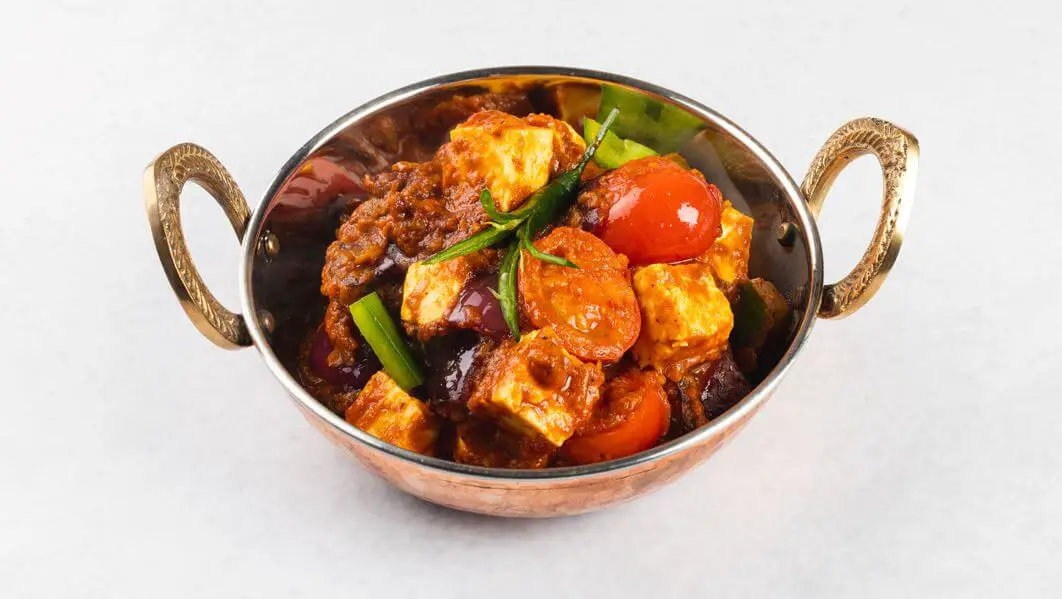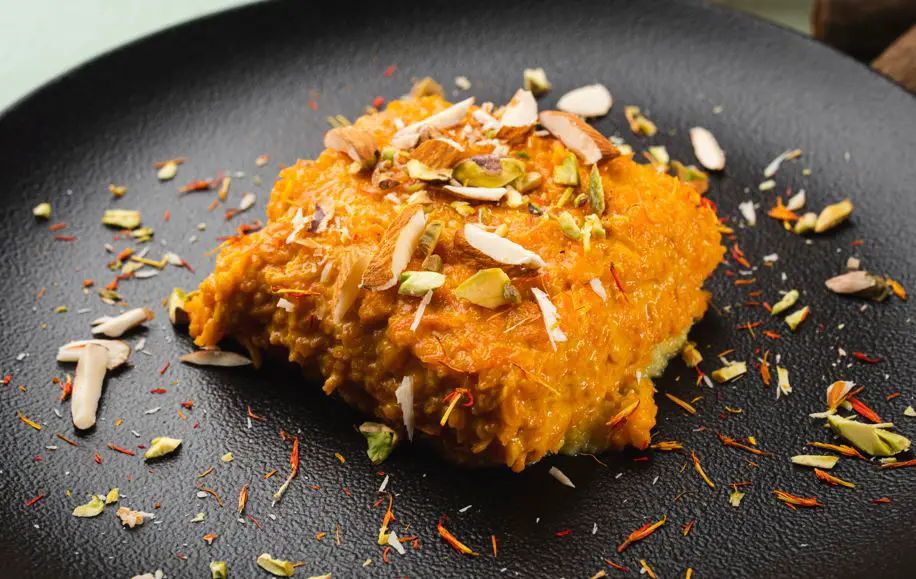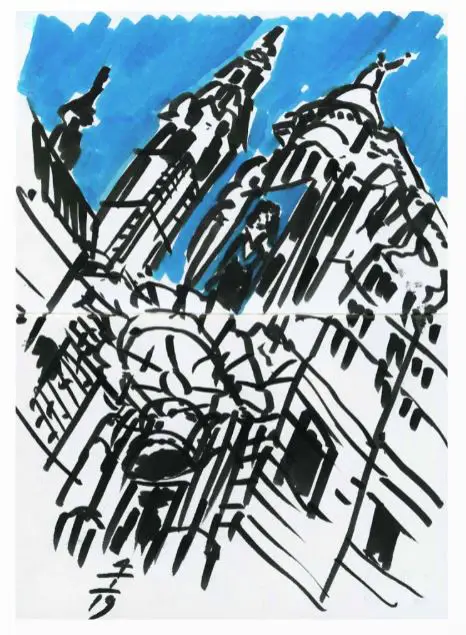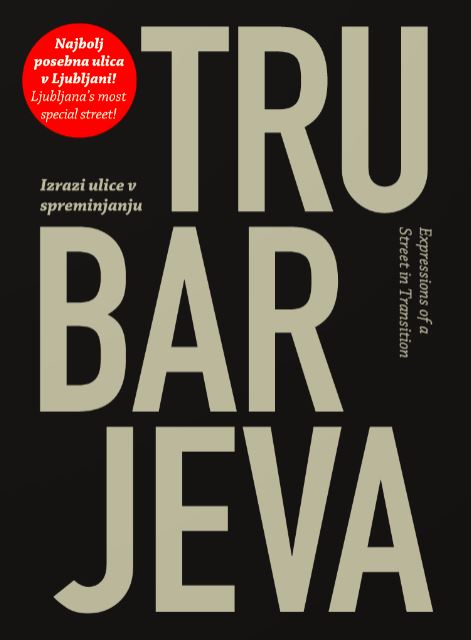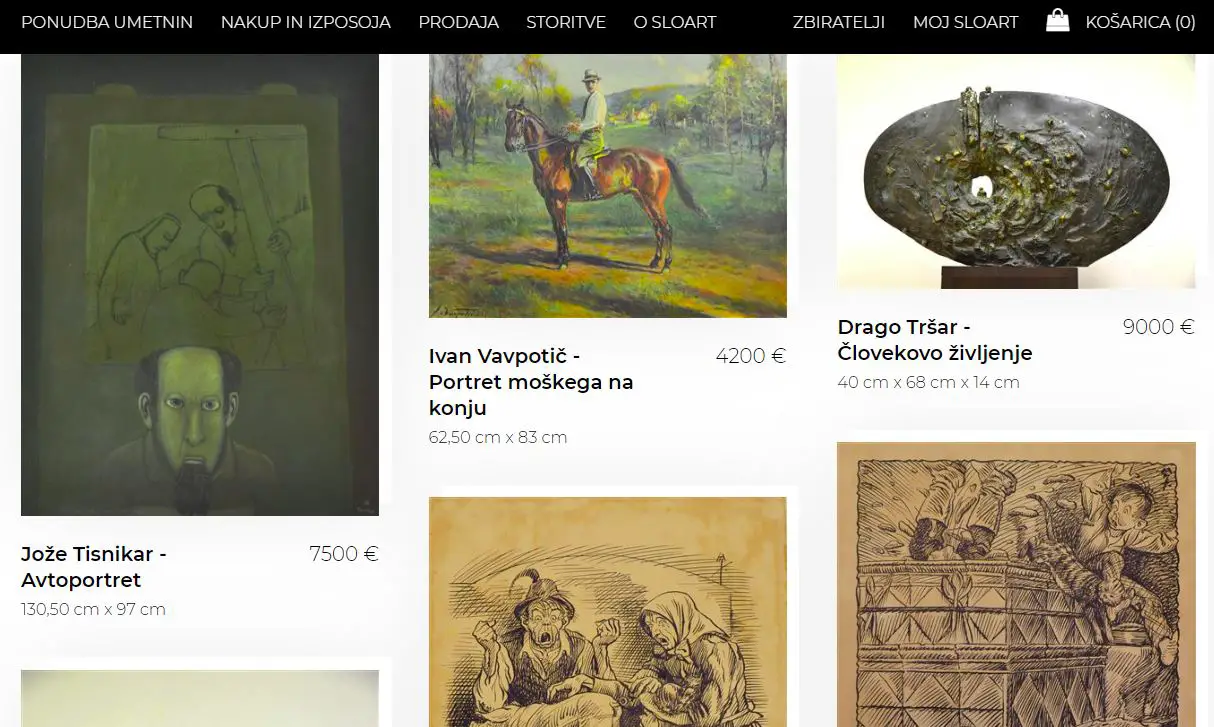Ljubljana related
STA, 25 May 2022 - Several alternative culture groups, NGOs and other initiatives called on Wednesday for a boycott of the emerging new creative centre at the location of Ljubljana's former bicycle factory Rog. They argue the city has been deaf to the proposals of the autonomous community that was evicted from Rog's dilapidated premises in 2021.
Addressing the press in front of the sizeable centre, which is being revamped in a EUR 20 million investment meant to be completed next year, the groups called for an open debate that would allow a democratic planning of the new premises.
The boycott initiative has been backed by the Autonomous Rog Factory collective, Ljubljana's counter-culture centre Metelkova Mesto, the Youth for Climate Justice, members of Radio Student, the Collective of culture workers, the anthropology department of the Faculty of Arts and several other groups.
The grievances include unsolved issues related to the police-backed eviction of Rog's users in January 2021 by the City of Ljubljana and what the protesters see as the exclusion of all but "the obedient partners of the city authorities" from the planning of the new centre.
While calling for a public discussion to exchange ideas, they pointed to alternative proposals that Rog's users already put forward in 2019 in an effort to make the centre a model for self-organisation and active participation.
One possible solution would be a cooperative-like model that would allow workers with precarious labour arrangements, the unemployed and refugees to receive training in construction work, crafts and administration.
The other would involve full autonomy, with the city committing to respecting the principle of self-organisation and the centre's users to the organisation of non-profit activities for the public good.
The protesters, who say the city has refused to discuss these options, hope for some support from new government given the size of the project.
The Rog Centre responded by saying it had been cooperating with a number of NGOs and initiatives, as the centre's development was the largest example of community planning so far.
Its programme as part of the RogLab project has been created since 2010 through a broad participative process. More than 6,000 users, 450 experts and 80 partner organisations from Slovenia and other countries have been involved so far.
"Both the interested former users and the wider public participate in conceiving the programmes, as well as its neighbours, as it is designed to be a publicly accessible space uniting very different communities. Anyone who is willing to take part can join this process at any time," Rog said.
Rog Centre is in the purview of the City of Ljubljana, which announced in April the centre would promote cultural and creative activities, especially product making, applied arts, architecture and design.
Plans include seven production labs, including for textile, wood processing, ceramics and glass, and green and culinary labs, for which there will be a membership fee similar to a library fee.
A total of 25 production units will be available free of charge based on calls for applications. The use of the facilities will be limited to three to four years. Five residential units will be available to users from abroad, the project's representatives announced.
The centre will also have a large area for socialising and exhibitions, a library and cafes. There will moreover be two smaller shops where products manufactured at the labs will be sold.
The building will have four floors and a total of 8,500 square metres. Outside the building a park will span 8,000 square metres.
STA, 19 January 2022 - Members of an autonomous social and cultural community that had squatted the defunct Ljubljana bicycle factory Rog for years before being forcefully removed from the premises a year ago warned at a press conference on Wednesday of what they perceive as shrinking of the public space. They also reiterated that the eviction had been illegal.
Addressing the press to mark the first anniversary of the eviction, the squatters said that many of them had lost their home during the eviction, a place to create and work, while in a wider sense an important hub for promoting self-organisation, developing a critical, anti-authoritative thought and solidarity and support has been lost.
They believe Rog was "one of the last strongholds of the culture of living that is not, cannot and will not be a commodity".
The Rog premises were not empty when the demolition started and the Ljubljana municipality crashed into the building without a court order or a bailiff, they said, adding that the police had participated in this illegal activity, preventing residents from accessing their belongings and animals.
They claim that the municipality then tried to conceal the crime by misleading the media and launching a smear campaign against the "victims of the mayor's violence".
Many Rog squatters have lost everything in the ruins, including trust, and nothing has happened in the past year that would restore their trust in the city's policies.
They still do not know where to find their belongings, and finding a place to live and work that would at least to some extent compensate for what has been lost has become increasingly difficult.
"The city is becoming increasingly closed as a public space, controlled and cleansed of any 'anomalies', so many of us feel like we no longer belong here," they stressed.
A rally against social cleansing of the city has been announced for 6pm in the Tabor park to point to privatisation of public space in the city, and adjusting to tourism and other businesses while citizens, especially those who are not well-off are increasingly being pushed to the margins and the social bottom.
A group of culture workers joined the activities marking the anniversary of Rog eviction. They said the rally would be a "political campaign, which will also present art installations, performances and other ways of expression to show how public space can be filled and clearly say that the city belongs to the people not the interests of the capital".
The Ljubljana city authorities launched construction work on the site of the former Rog factory on 19 January 2021. Squatters were forcefully removed from the premises with the help of police. In April the public institute Rog Centre was founded.
The new Rog Centre is to house more than 500 artists and creative groups at more than 8,000 m2, according to the municipality. It will also feature 20 new production halls that will be available for short- or long-term use to different production groups.
The project has been estimated at EUR 27.6 million.
Despite the growing number of Chinese restaurants, Slovenia still isn’t a great place for non-European food, and it’s only in the last decade or so that Ljubljana itself has seen more diversity with regard to its dining offers. Much of the excitement there is concentrated on and around Trubarjeva cesta, the colourful but rapidly gentrifying street that runs from Prešeren Square towards one or two of centres of contemporary culture, the Metelkova-Gallery-Museum quarter, and the newly opened Cukrarna.
I lived on the street my first few years in Slovenia, one of the less vibrant members of the immigrant community, albeit one with a long and abiding interest in the spicier end of cuisine towards the other end of Eurasia. Which is why when chef Ziauddin Ahmed started serving food from the subcontinent at Hotel Park (now the B&B) a few years ago I was a very happy customer, joining many others who travelled from far further afield to enjoy his work.
See the full menu. Photo: Zaika
I left Ljubljana two years ago, just at the end of 2019 and a few months before the lockdown put the hotels, restaurants, bars, cafés, clubs and so on through the worst times anyone can recall, and it’s already clear that when this whole mess finally ends the scene will have changed significantly, with some businesses closing, others successfully evolving.
One of those changes to the scene involves Ziauddin, who in March of this year took over the small space at Trubarjeva 60 that previously hosted the Bangladesh restaurant. The place (Zaika) was fully cleaned and renovated, and set up for takeaway and delivery service, making best use of the small space and central location to bring colourful, exotic, and delicious new tastes to the street, with meat, vegetarian and vegan options.
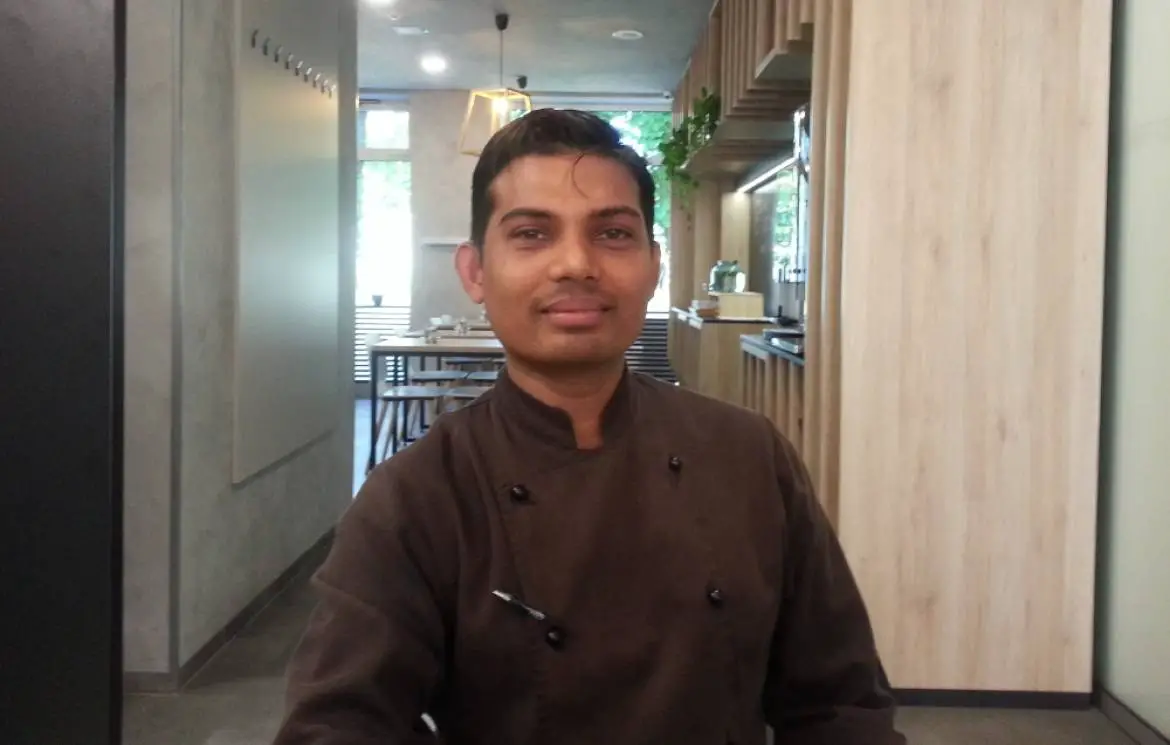
Ziauddin Ahmed, photographed in another location. Photo: JL Flanner
I know Ziauddin from way back, so here’s a little of his story and that of Zaika, which you should check out and support if you’d like more of this kind of thing in town.
How did you end up in Ljubljana?
I’m from Kolkata, West Bengal. I did my master’s degree in the hotel industry. After that I got a job in a five-star super-deluxe hotel, the Hyatt Regency Kolkata. So I started my career from there, and I worked there four and a half years, then I got a chance to come to Ljubljana as the head chef of Figovec, when it was an Indian restaurant, called Currylife Figovec, and then I worked at Hotel Park for a few years, until COVID changed everything.
Are people here open to trying Indian food?
Yes, many people in Ljubljana love Indian food– but still many of them are scared of trying it because their perception is that it’s very spicy, maybe there’s no option for vegans, and the like.
Slovenia is still a young country, so I feel it will take little more time for people to get used to Asian flavours, dishes and spices. That said, recipes are not written in the Bible, so you can change them and make good food according to a customer’s taste-buds and choice, they just need to let me know before I start cooking. To my mind, that’s the real difference between a chef and a cook. A cook just follows the recipe, but a chef can adapt it and always make something that pleases all of the senses, no matter what needs to be changed.

See the full menu. Photo: Zaika
How do you like Slovenia?
I like it very, very much. That’s why I came back. It’s a really beautiful country. I like nature and I am not a person for very crowded places, so i can say it’s perfect for me.
You also have a mixed culture. Most of the year – when there’s no epidemic – the city is dominated by tourists from all over of the world.so you can also enjoy the different cultured people here. And that’s a very beautiful thing about this country. Not overpopulated, very nice people, very friendly.
What about the winters?
Honestly, I’d never experienced that kind of temperatures in my entire life . At my birthplace temperature goes maximum 10 degrees Celsius, and we think “oh, it’s too cold”. When I came here it was minus 15. I was scared that I’d die. But the human body can acclimatise very quickly. Now it’s become normal.
What about Slovenian food?
Well, as a Muslim I can’t eat pork, so when I go out I’m always a little bit scared, because most Slovenian traditional foods are dominated by pork or use pork fat to enhance the flavour. But I like štrukli, žlikrofi, prazen krompir, pasta, although bolognese, again, I worry there’s a little pork fat in there, because fat always gives a good taste.
See the full menu. Photo: Zaika
How many people are working at the new place?
I’d like to get some help with the cooking, but until then I’m the only person here – ordering the ingredients, cooking the food, keeping the place clean and the customers happy.Enter
Who are your customers, and what things sell well?
I get both tourists and locals, because that’s who comes to Trubarjeva. There’s a great slection of Indian curries, but the best-selling items are chicken makhani, tikka masala, subz diwani, hundi kofta, nazakat and naan.
Zaika offers service, takeaway and delivery of meat, vegetarian and vegan dishes from 11 – 21:00 Mon-Saturday. iIt’s very easy to find at 60 Trubarjeva cesta, just down from the famed Trubar café, home to among the best doughnuts in Ljubljana, and – incredibly – still in business after I left town and stopped drinking there.
See the full menu. Photo: Zaika
That café, cake and ice cream store is in good company with the many other small eateries, bars and boutiques that make Trubarjeva a must-see street that’s easy to overlook but much easier, and more fun, to visit, leaving you well-positioned for the various attractions there or just a short distance away, or a pleasant walk along the river, perhaps with an ice cream in hand and your heart open to the life of the city.
STA, 27 January 2021 - In just over a week after the Ljubljana City authorities started clearing out the disused bicycle factory Rog following contested squatter evictions, large quantities of what appear to be stolen goods and drugs have been found at the old factory complex, according to the Ljubljana municipality.
The municipality said in a press release on Wednesday that the city's utility company had found a number of new household appliances, still in their original packaging.
Moreover, a large amount of used and new drug needles, as well as large quantities of illegal substances, were also found, the press release said.
Workers clearing out the premises also found nearly 400 bikes, bike wheels and bike frames, many of which seem quite new, the press release said, adding that the police had been notified of these finds.
The press release also said that all belongings of former Rog residents had been recorded and are now available for takeover.
So far, nearly 43 tonnes of waste has been removed, with the utility company estimating that at least three time as much waste still remains on the premises.
"Most of the rooms at Rog were literally overflowing with waste. This, in addition to dangerous chemicals in the galvanising section of what was once a leather factory and asbestos roofing, makes for an environmental time bomb," the press release said, referring to the leather factory that operated on the premises before these became a bike factory.
The Ljubljana municipality also said today that it started tearing down "dangerous and dilapidating constructions near the main factory building, which, in turn, is listed as a cultural monument and will be completely renovated".
The municipality is determined to clear out the waste as soon as possible, so that the planned investments may be launched in a few months, the press release said.
The new Center Rog is to provide more than 8,000 square metres of modern production space for more than 500 artists and creative groups, it added.
STA, 22 January 2021 - Several associations have expressed support to members of an autonomous social and cultural community who were evicted from the defunct Ljubljana bicycle factory Rog earlier this week. The Slovenian PEN centre condemned the "brutal violence" with which there were evicted, while Mayor Zoran Janković rejected accusations.
Members of the PEN centre said the incident was "unbecoming of democratic Slovenia" just as the attitude towards a Radio Študent journalist, a retired Večer journalist, and writer Vesna Lemaič.
"Their mission to report and write about the developments was jeopardised in the most brutal way and thus freedom of speech was jeopardised, which is something we are particularly aspiring for in the spirit of the PEN Charter."
The centre regretted that dialogue had been completely abandoned and that "violence spoke instead". It called on the municipality to protect the personal items of the members of the community which they have been unable to take with them or pay them compensation, and foremost offer them new rooms.
"Their art is the soul and image of our capital Ljubljana, which encourages culture and is UNESCO's city of literature. Dialogue is undoubtedly the only democratic way to a solution to this problem," the centre said.
Nova, mogoče zadnja alineja v zgodovini tovarne in Tovarne Rog, simbola avtonomije, kreativnosti, solidarnosti in koles.https://t.co/dr8sj3TmAv#tovarnarog #Ljubljana #občina pic.twitter.com/YHOSV0MhFb
— Vsakdanjik (@vsakdanjik) January 19, 2021
The Rog community was also supported by the local Ljubljana committee of the Left party, the Asociacija society, NGO Peace Institute, and the Association of Culture Workers.
The latter said the battle for Rog was a battle for "all of us who do not accept the dictatorship of the capital culture". It noted that the cultural community there was "precious not just for the city but also wider".
In the last 15 years, Rog has been a "centre of critical thought, a hub for social movements, a sanctuary for all those who are being marginalised by the capital", a "place of friendship, comradeship, ideas and projects".
"Rog has been a symbol of all those who are rejecting profit, gentrification, rightist violence, capitalist repression, Janšist Orbanisation," reads a press release issued by the association.
Author and artist Svetlana Makarovič said after the incident she was renouncing her title of honorary citizen of Ljubljana. In a statement for the STA on Thursday, she said she was "deeply hurt and outraged by the thoughtless and harsh eviction of Rog residents, especially because animals that had shelters there were also subjected to the violence."
Ljubljana Mayor Zoran Janković responded to the incident on Thursday, saying that nobody had been at the defunct factory at 7am on Tuesday, when workers accompanied by security guards entered the premises to start demolition with a construction permit after all attempts of mediation failed and based on all court rulings in favour of the municipality.
Supporters of the Rog community and members of the community started to gather in Trubarjeva Street later, and tried to enter the Rog area in a violent way, which police prevented, he said in a Facebook post, stressing that the violence had been provoked by those who wanted to enter Rog in a violent way.
He said that all items that are not owned by the municipality would be recorded and taken to the Snaga waste collection centre in Povšetova Street, where owners would be able to collect them after a prior notice.
The mayor said the municipality planned to build a new Rog culture centre that would provide rooms for more than 500 artists and creative groups on more than 8,000 square metres.
STA, 19 January 2020 - Members of an autonomous social and cultural community that have been squatting the defunct Ljubljana bicycle factory Rog for years are being forcibly removed from the premises on Monday as construction work started on the site.
The Ljubljana authorities confirmed they had started tearing down buildings on the site as part of the long running efforts to remake the rundown site into a new creative hub.
Representatives of one of the activist organisations squatting the compound told the STA security guards dragged people out of the building with police standing watch, while the rtvslo news webs site reported police used tear gas against some individuals.
The Ljubljana Police Department (LPD) confirmed for the STA that the owner of the premises was carrying out construction work on the site, initially with the help of security guards.
Tovarna ROG:sesuvanje avtonomnega prostora?? pic.twitter.com/rvWVlnaFgC
— Društvo AREAL (@ArealDrustvo) January 19, 2021
The police were called in as persons gathering on the premises would not follow the guards' instructions, the LPD said, adding they had established violations of the public peace and order on the site and persons who did not follow police orders were fined.
The police said construction and security services had secured the building and checked whether there were persons inside to set up a building site. "The public order has been established and police will stay on the site to ensure it remains that way," the release said.
Video footage available online shows fences being put up and individuals being handcuffed and taken away by the police as some of the onlookers carried banner saying We're not giving up Rog.
The city, which has included the Rog makeover project in its 2021 budget, has been trying to take possession of the premises for years, including through courts. It most recently tried to evict the squatters in 2019 after winning a court battle against several of them.
"Having been notified in recent weeks that Rog is empty, we took possession of the premises, which are property of the Ljubljana municipality, today," the city authorities said.
They added that they had started demolishing work based on a development permit and "environmental remedy of the site, which is seriously degraded and dangerous" due to galvanic residues and structural instability of the buildings.
They are planning to publish a tender within a month to pick a contractor to renovate Rog, announcing that a new Rog Centre would be completed within two years to provide "premises to more than 500 creators and creative groups on 8,000 square metres of modern production space".
"By revitalising the site we will acquire a new creative meeting point and a hub linking the city centre, the Metelkova cultural centre, the new Cukrarna Gallery and Cukrarna Palace," they added.
In response to the developments, the local chapter of the Left party protested against what it called a renewed attack by the city authorities on the autonomous Rog plant, accusing the mayor of abusing the epidemic, also against NGOs helping those affected by it.
The party said the mayor secured an additional EUR 1.8 million for the Rog project in the revised city budget passed yesterday, while "social and education programmes that have been enriching the city for years will be erased [...] and alternative culture disabled".
A short film by Danilo Milovanović, made during the pubic shutdown dealing with the coronavirus epidemic, shows how Bosnian workers continue to work 10-hour shifts at various constructions sites in the centre of Ljubljana, from Trubarjeva to Gregorčičeva. In the film, with English subtiteles, you can learn about their concerns.
WORKING CLASS IN THE TIME OF A PANDEMIC from dnlmlvnvc on Vimeo.
I lived on Ljubljana’s Trubarjeva cesta for my first few years in Slovenia. I left because the rent was too high and the space too small, moving 30 minutes out of the city to a large place I’ve hardly left except for supplies since moving last December. It’s a nice place, a lot better than my apartment on Turbarjeva, but no one will ever write a book about the street it’s on.
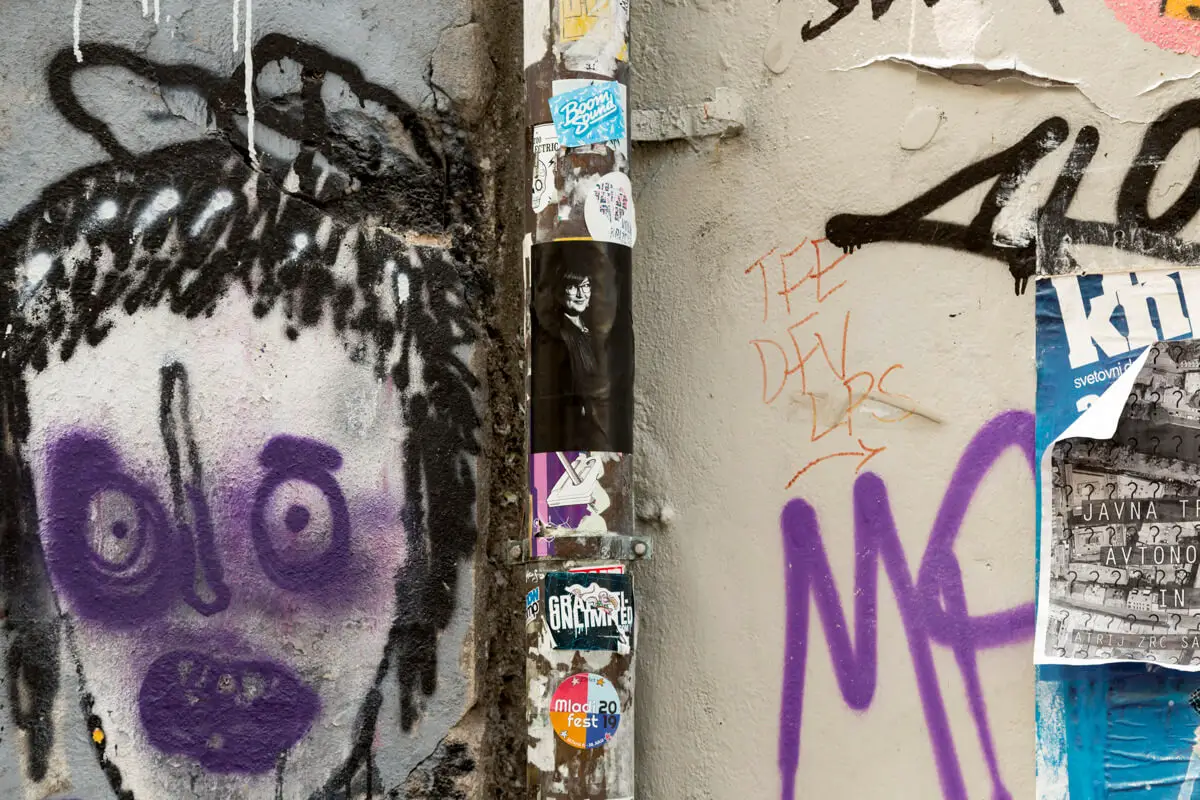
Graffiti is a big part of the street, especially in the second half. Photo: Manca Juvan (and if you're on the street around now you'll see some of her photos from the book on the walls)
Trubarjeva is perhaps the most diverse place in Slovenia. Split between the fancier end that runs from Prešeren to Resljeva cesta, the road with Dragon Bridge, and the more graffiti-covered, falling down and rapidly gentrifying dirty end. The former starts with the Emporium top brand store, while the latter ends with the Rog squat, a what now seems to have been a failed attempt to establish an autonomous zone in a former bicycle factory, a space that’s set for glossy redevelopment.
With sketches by Blaž Budja, this one showing Emporium
And it’s not just Rog. Starting last year the street has been undergoing extensive renovation work, as befits its status as one of the more trafficked parts of downtown, by tourists and residents who want something different, and it’s rising profile in the city (the book this article will eventually get to was supported in part by the City of Ljubljana).
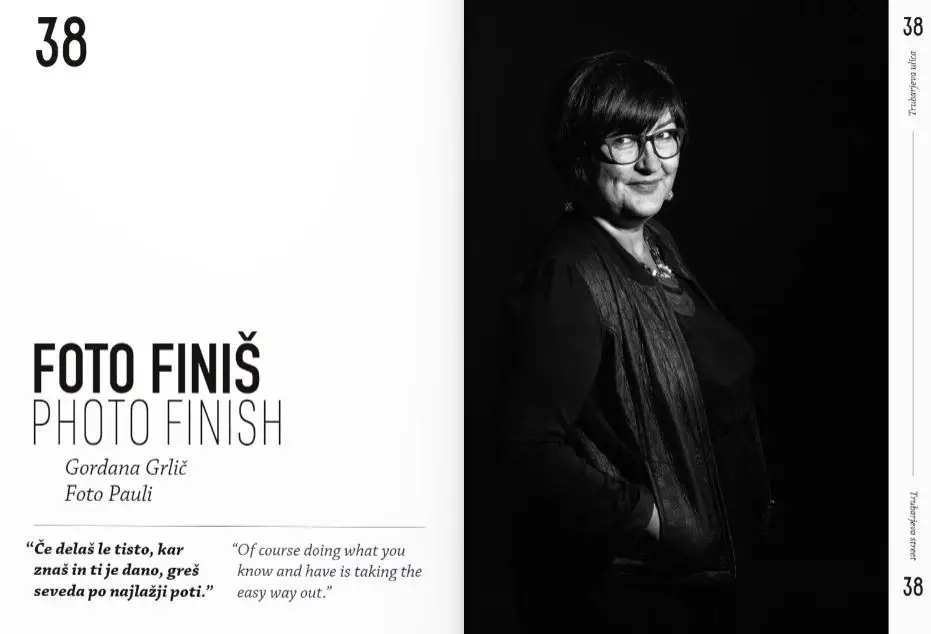
The book features interviews with local residents and business owners - in Slovene and English for maximum educational potential. if you need a photo, go to Foto Pauli and see Gordana. I trusted her with my passport photo / author picture / Facebook profile.
Tourism and Airbnb, among other reasons, are why property prices are rising fast in Ljubljana, and with them the rents. This is changing the character of the people who can afford to live there, and the businesses that can afford to operate. But Trubarjeva is still not the Old Town, and there are many businesses used by locals for necessities and minor indulgences.
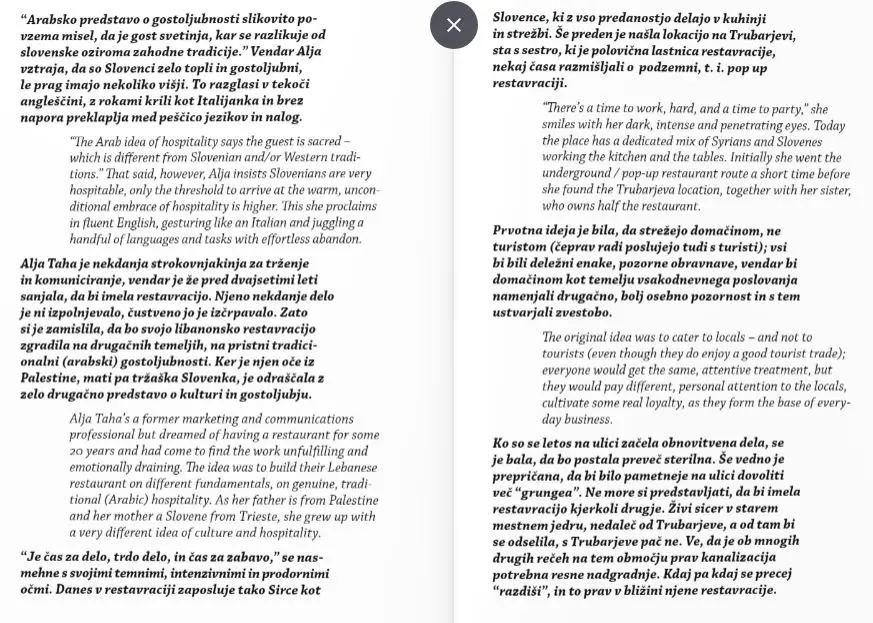
What draws most is the variety of restaurants, from cheap to more expensive, with the mix at the time of writing including Chinese, Vietnamese, Indian, Bangladeshi, Thai, Italian, Lebanese, Turkish, Vegan and Slovenian, without even going into Skuhna and its rotating menu of dishes from Africa, South America and beyond, along with a great spice shop and Asian store.
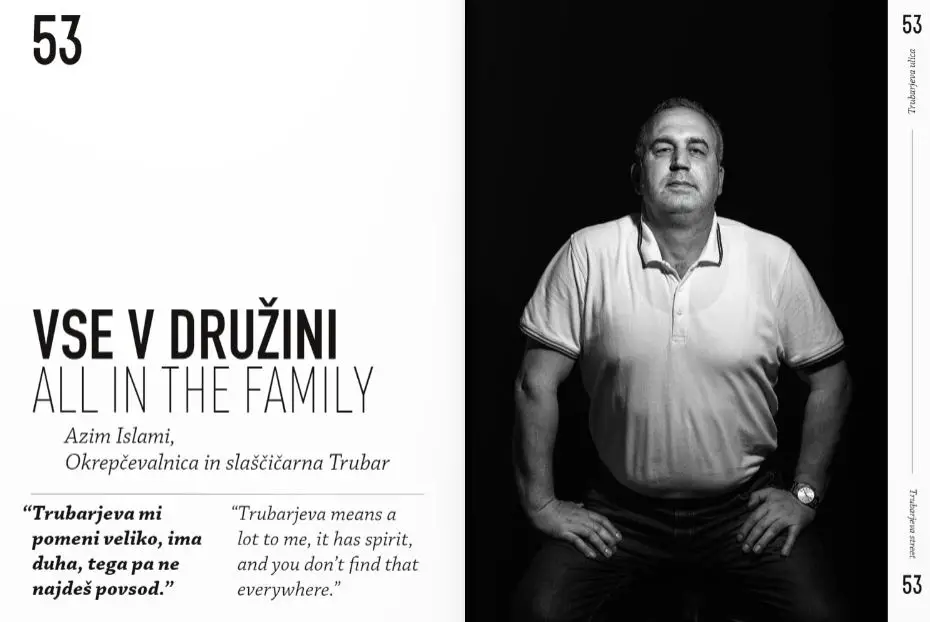
There are also some good cafés and bars, with Trubar alone seeing more of my income than anyone other than my landlady in my time on the street, although in some months it was close.
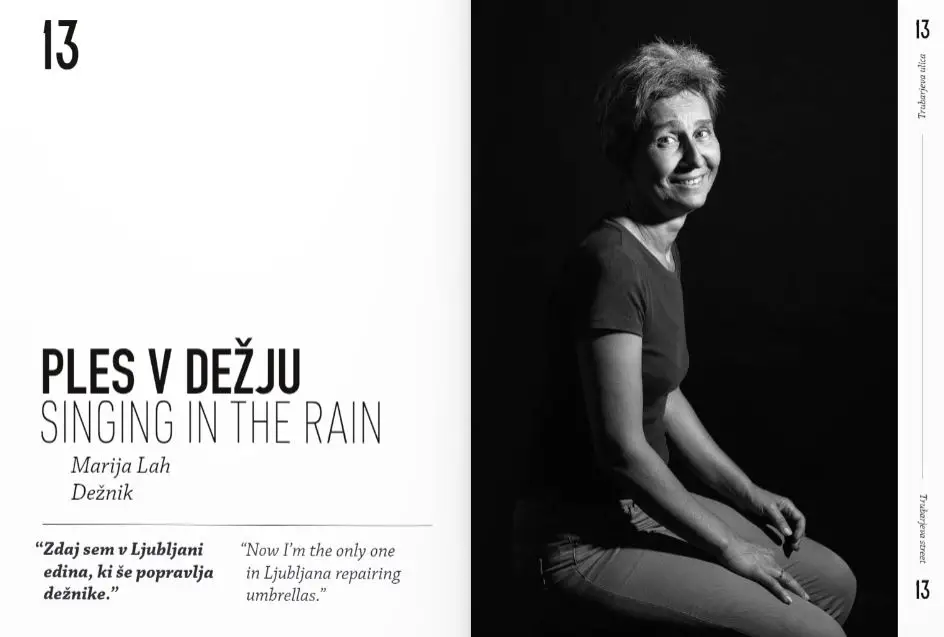
That umbrella repair store? You can see a documentary on it here
Beyond restaurants and bars, on Trubarjeva you can buy buttons and beads, get your watch or shoe repaired, try a fur coat and second-hand clothes, antiques and art, bread and burek, sex toys and vaporisers. Have your photograph taken or get your hair cut, choose a skateboard or new pair of glasses, a book or umbrella, ride off with a bicycle, equip your home for growing marijuana or stock your fridge with craft beer, purchase health food or handmade chocolates, go to a rave, work with some refugees, attend the "Sigmud Freud University" or watch some graffiti get made. Something for almost everyone.
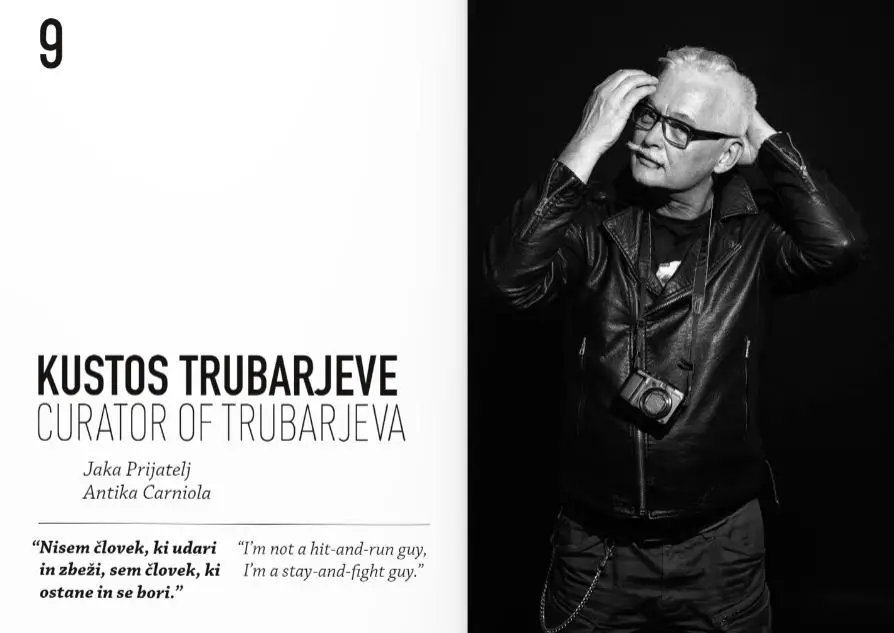
You can read our story on Antika Carniola here
Which is to say I’m the ideal reader for a new book, Trubarjeva, Expressions of A Street in Transition, which is being launched next week but can currently be viewed entire online and a paper copy ordered here.
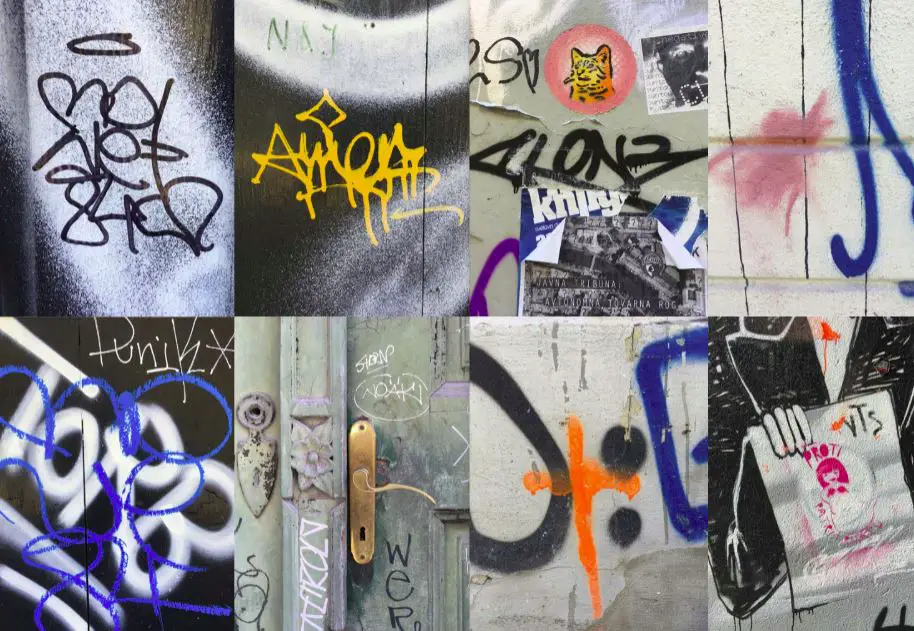
With texts by Jeff Bickert, in Slovene and English - so great for learning the language, sketches of the street by Blaž Budja, photographs by Manca Juvan and design by Sava Kosmač, it’s a 144-page look Trubarjeva with a variety, colour and cool that are worthy of the street itself. Structured around interviews with people who live and work on Trubarjeva, with faces familiar to anyone who hangs out there a lot, you’ll learn how the street was, how it is, and some of the hopes and fears for the future. Trubarjeva is a unique part of Slovenia that’s changing fast, one that may not survive in its current form for many more years, so it’s good this book is here to document a time of transition.
All our stories on Trubarjeva can be found here
The world of Slovenian craft beer is a fast moving one, and to help you follow the latest developments we’re hoping this will be the first in a series on what’s new, put together with aid of Damir Galijaš, the multi-lingual, multi-talented man behind the Lajbah Pub (Grudnovo nabrežje 15, Ljubljana) and the Že V Redu, Primož beer store and tap room (44 Trubarjeva cesta, Ljubljana), both offering a huge, varied and evolving selection of the best local and imported craft beers.
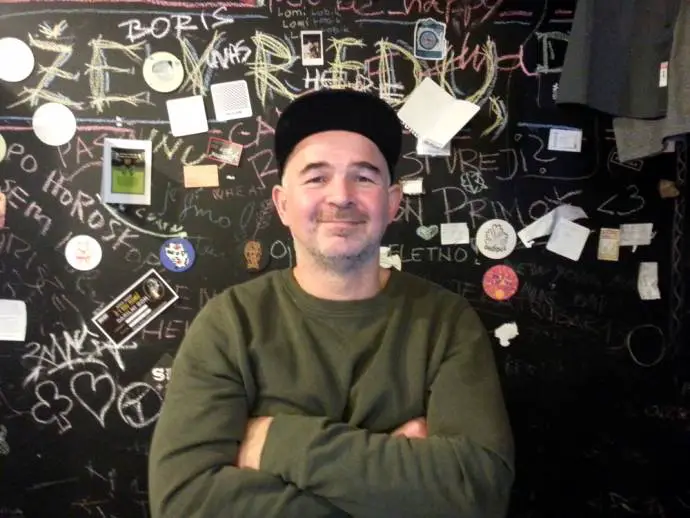
"When I go out I drink a pale ale, then an IPA, a sour, double IPA and finish with an imperial stout."
Here are four recent Slovenian craft beers, and one cider, that Damir has been enjoying, in the words of the man himself.
"Dr Orel is back. It was one of the first craft breweries in Slovenia, and it was totally focused on gluten free beer, which was good but ahead of its time. Now Hopsbrew (Domžale) have bought the licence and they’ve relaunched it, which I think is going to become more and more popular."
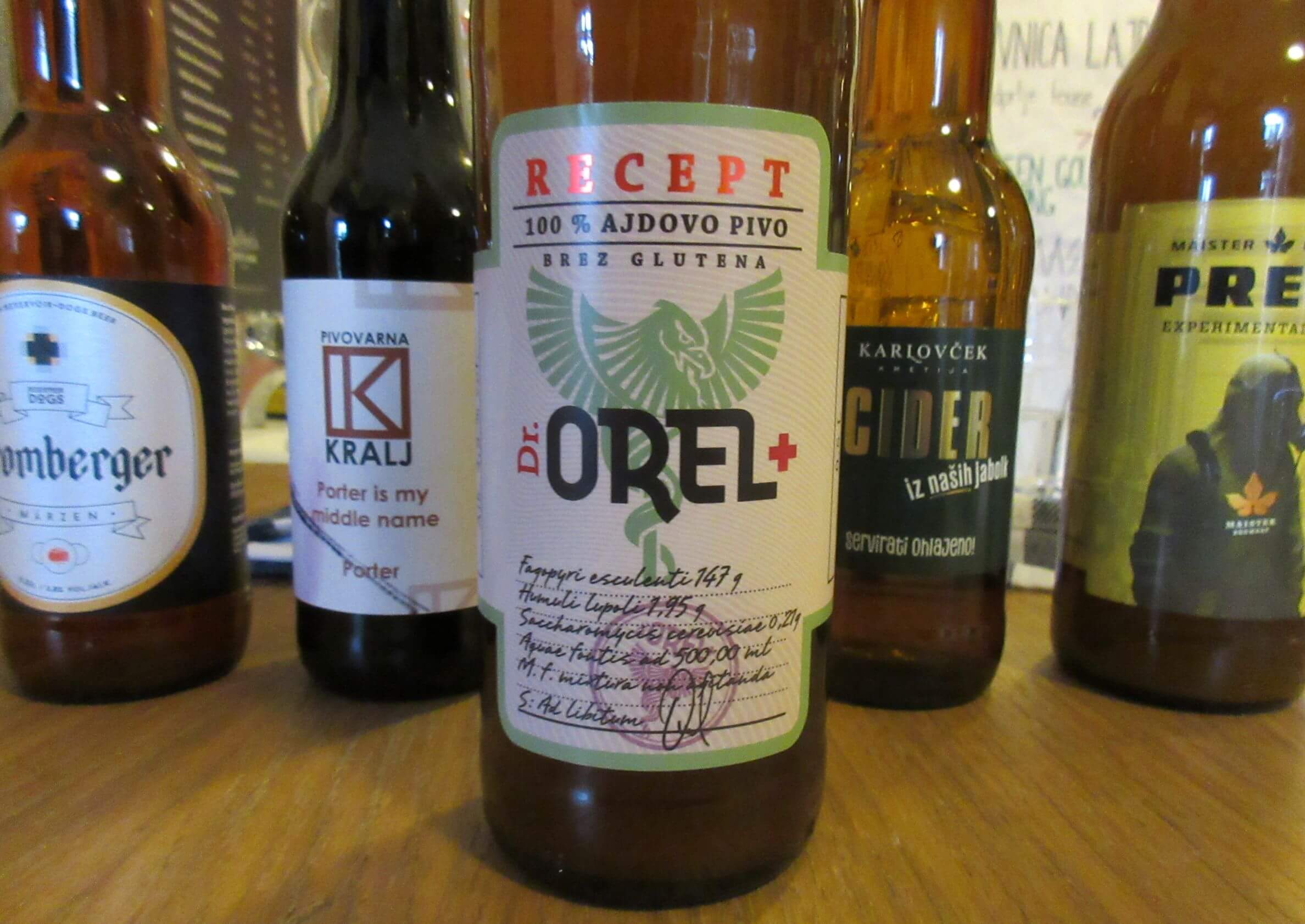
"This cider is from Karlovček, a small farm in Šentjernej with lots of apples, and so they started to make a craft cider. Of course it was very popular over the summer, but it’s gluten free and so on, so it’s something you can enjoy all the time."
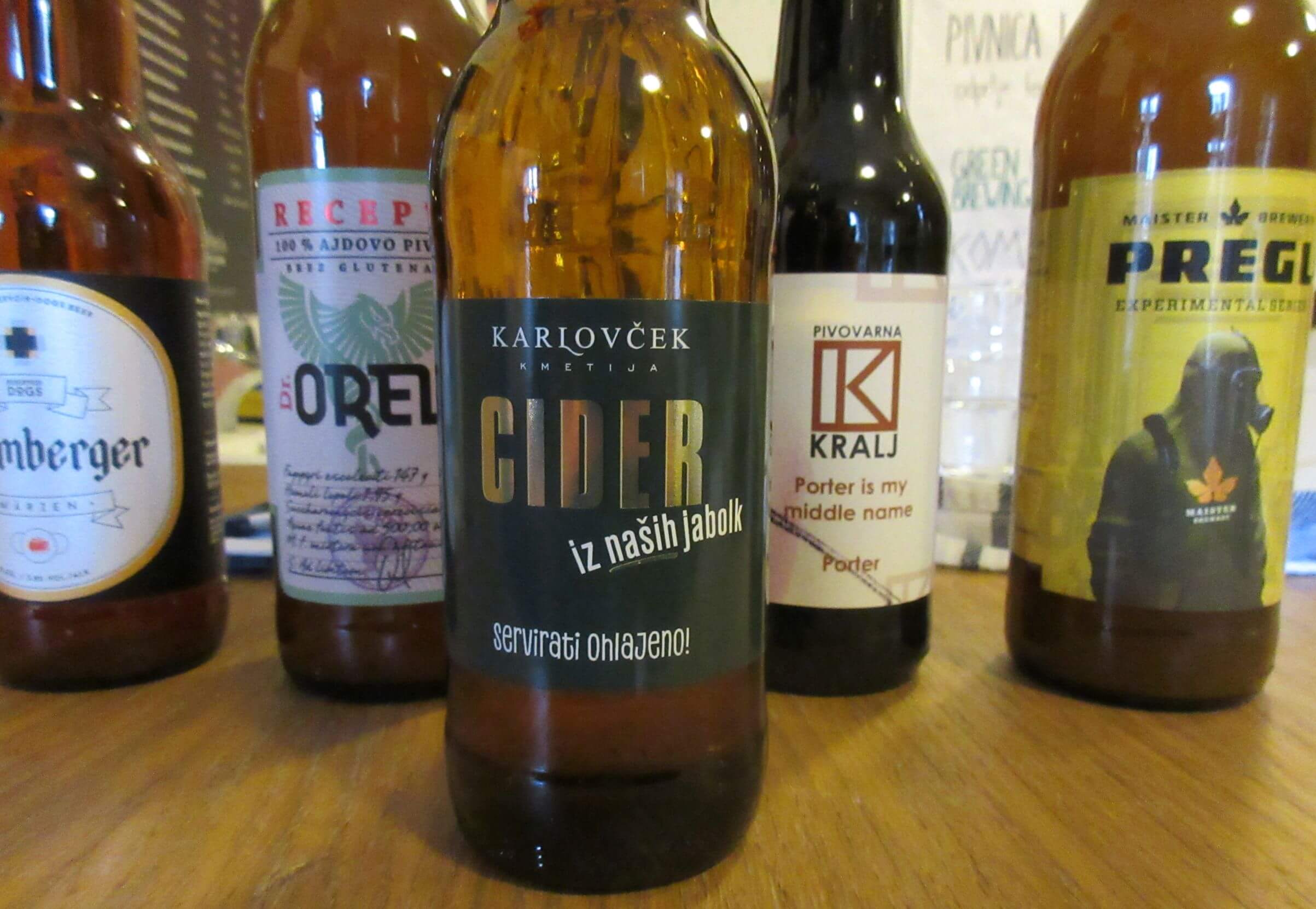
"This is a coffee porter from Pivovarna Kralj, a very small brewery with very nice beers, based on the outskirts of Ljubljana. They have an old farm that’s now a brewery. This porter is fantastic, which we also have on tap at Lajbah, with a very good price and performance. Going into autumn and winter the dark beers will be more popular, and this is a great one to sit on the couch in the evening and enjoy alone or with a friend."
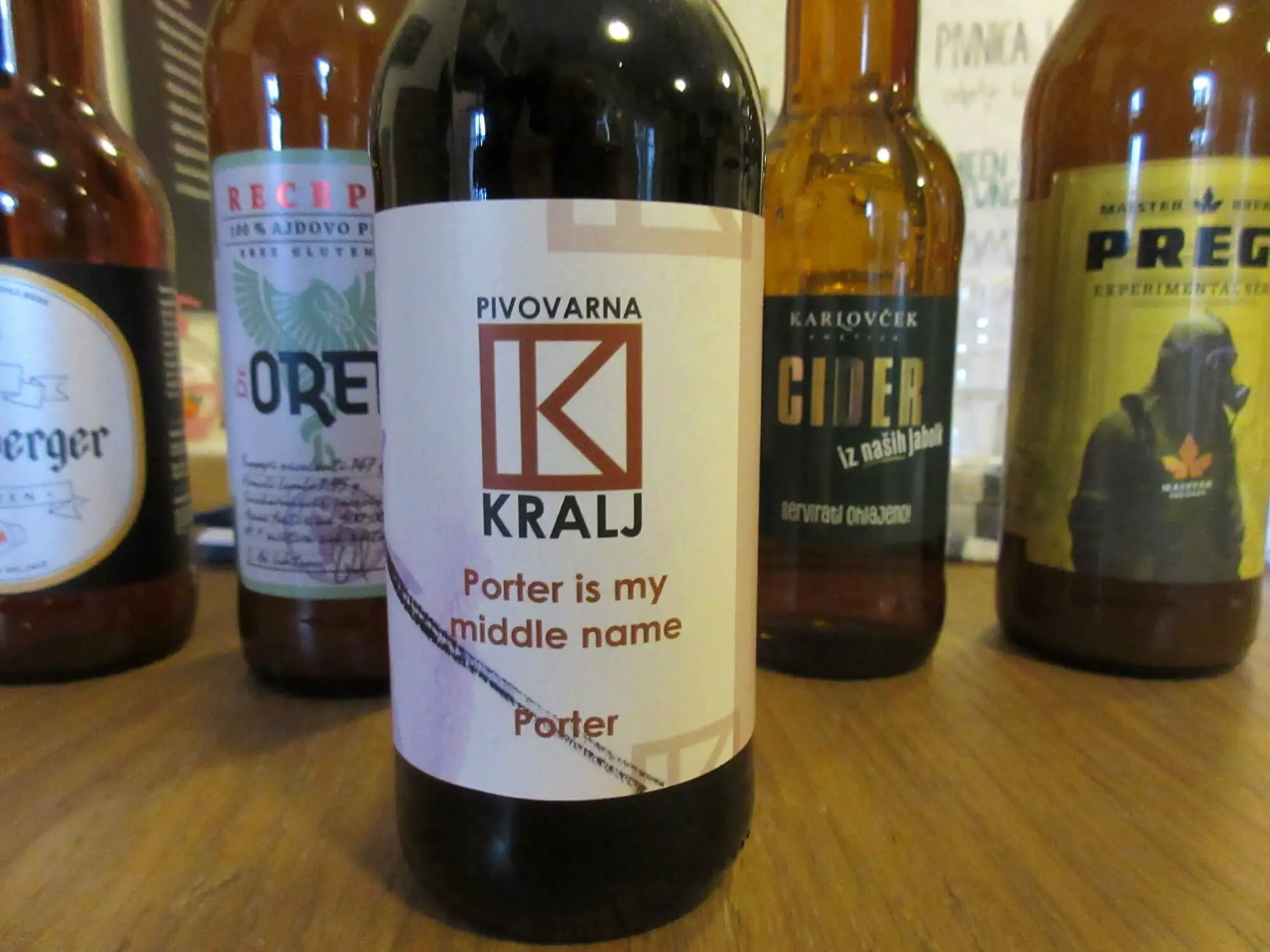
"This is the new Kromberger pilsner from Reservoir Dogs, in Nova Gorica. It’s a fresh beer, maybe just one month old, and a craft beer for people who don’t like craft beer."
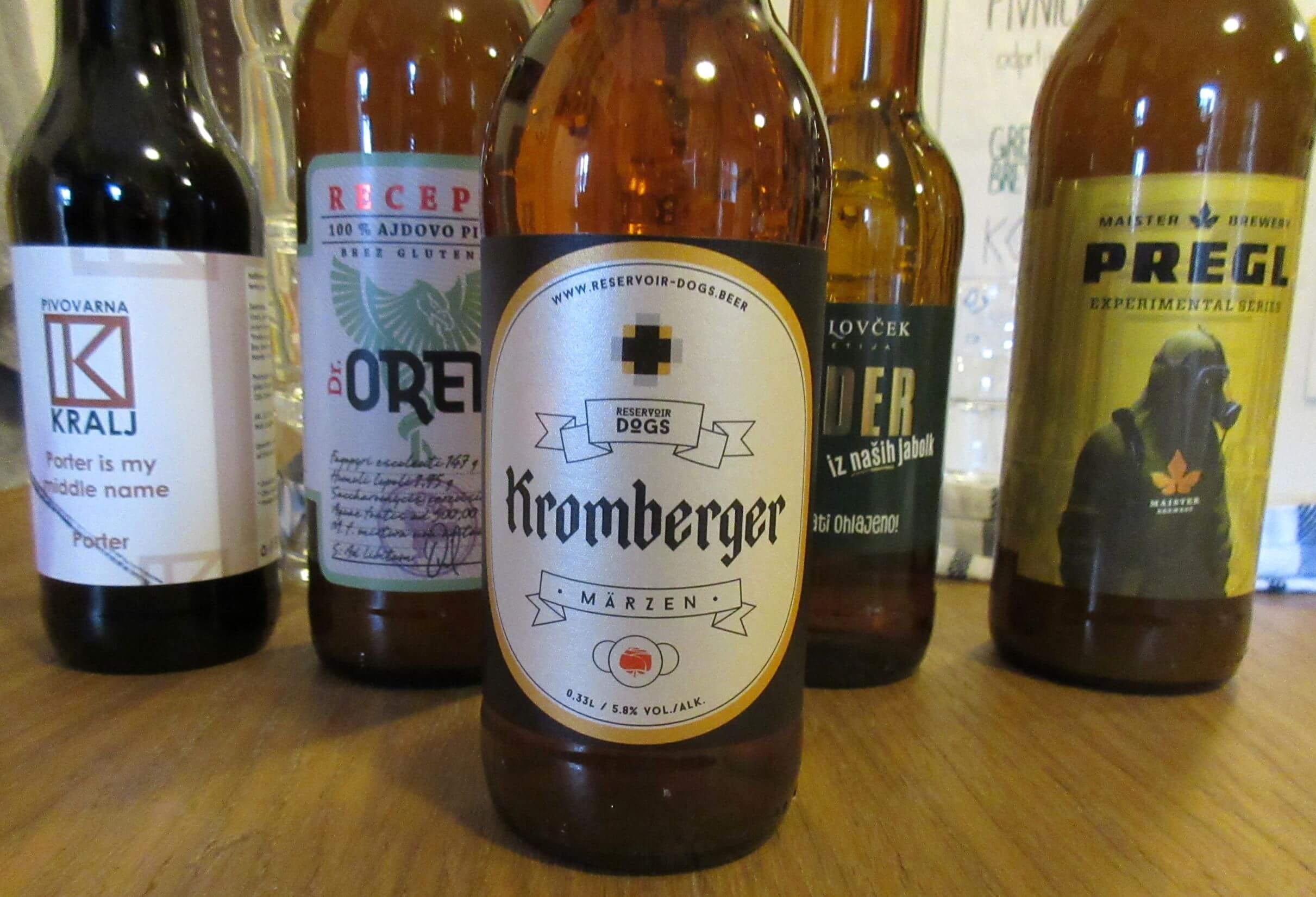
"Pregl is new beer from the experimental range of Kamnik’s Maister Brewery. A very nice sour with passionfruit and mango."
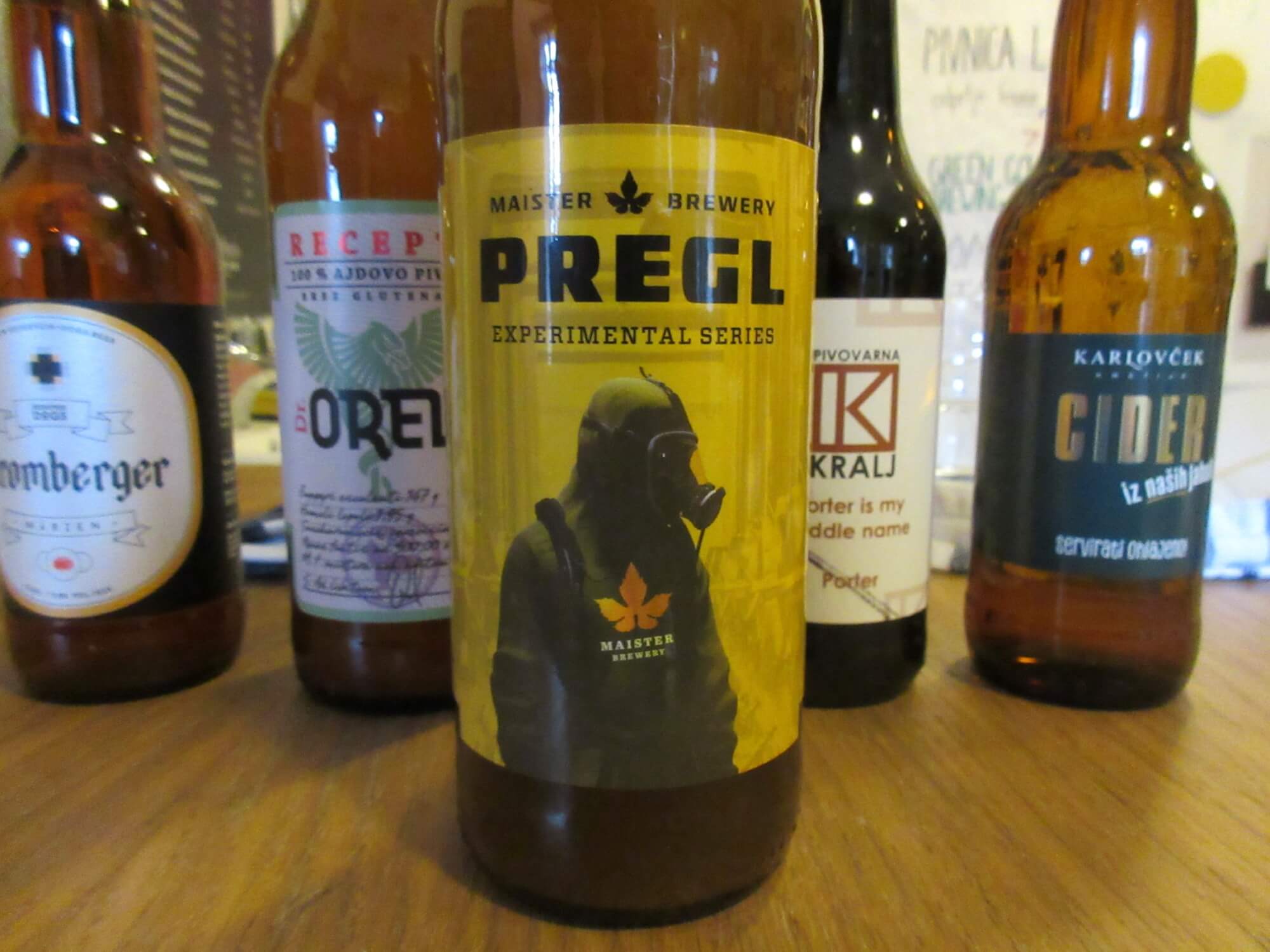
All our stories on craft beer in Slovenia are here
Art enlivens life and soothes the soul, can change how you see the world, can change the world, and – like a good rug – really tie the room together. We were thus thrilled to learn about SLOART a few months ago, which, as we found out in an interview with the owner, Damjan Kosec, aims to connect Slovenian artists with buyers and collectors, using both an online platform and real world gallery. Moreover, aware of the scandals, fraud and other shady practices that have damaged the Slovenian art market in recent years, SLOART focuses on providing the transparency and trust needed to make the scene work in the interests of both artist and buyers.
Related: Ljubljana’s Modern Gallery Highlights Recent Painting in Slovenia
As we noted at the time: It offers works from 1800 to the present day, and even just a passing familiarity with the biggest names of Slovenian art, as seen in the National and Modern Galleries, will make clear what an impressive list of names SLOART offers. Names such as Drago Tršar – the subject of a major retrospective earlier this year, and the man behind many of the most well-known sculptures in Ljubljana; Hinko Smrekar – who did the illustrations for much-loved edition of Martin Krpan; Zoran Mušič – who has his own room at the National; or Rihard Jakopič, the leading Impressionist who founded the school that would go on to become the Academy of Fine Arts at the University of Ljubljana. Beyond the dead there’s the living, with exciting works by current artists with years of work and discovery ahead of them.
Some of the works on offer on the SLOART website
This week the brick-and-mortar version of the project, Galerija Y (with the Y pronounced “epsilon”), at 79 Trubarjeva cesta, the end of the street away from Prešeren Square, opened a new show, Nove Pozicije (New Positions). This showcases works from four of the gallery’s contemporary artists, Tina Dobrajc, Duša Jesih, Arjan Pregl and Sašo Vrabič, which are also for sale. These are paintings, not conceptual art, and so no artists' statements are needed or provided. You can enjoy some of them below, along with pictures from the opening to give a sense of scale, or see them in person until 18 October 2019.
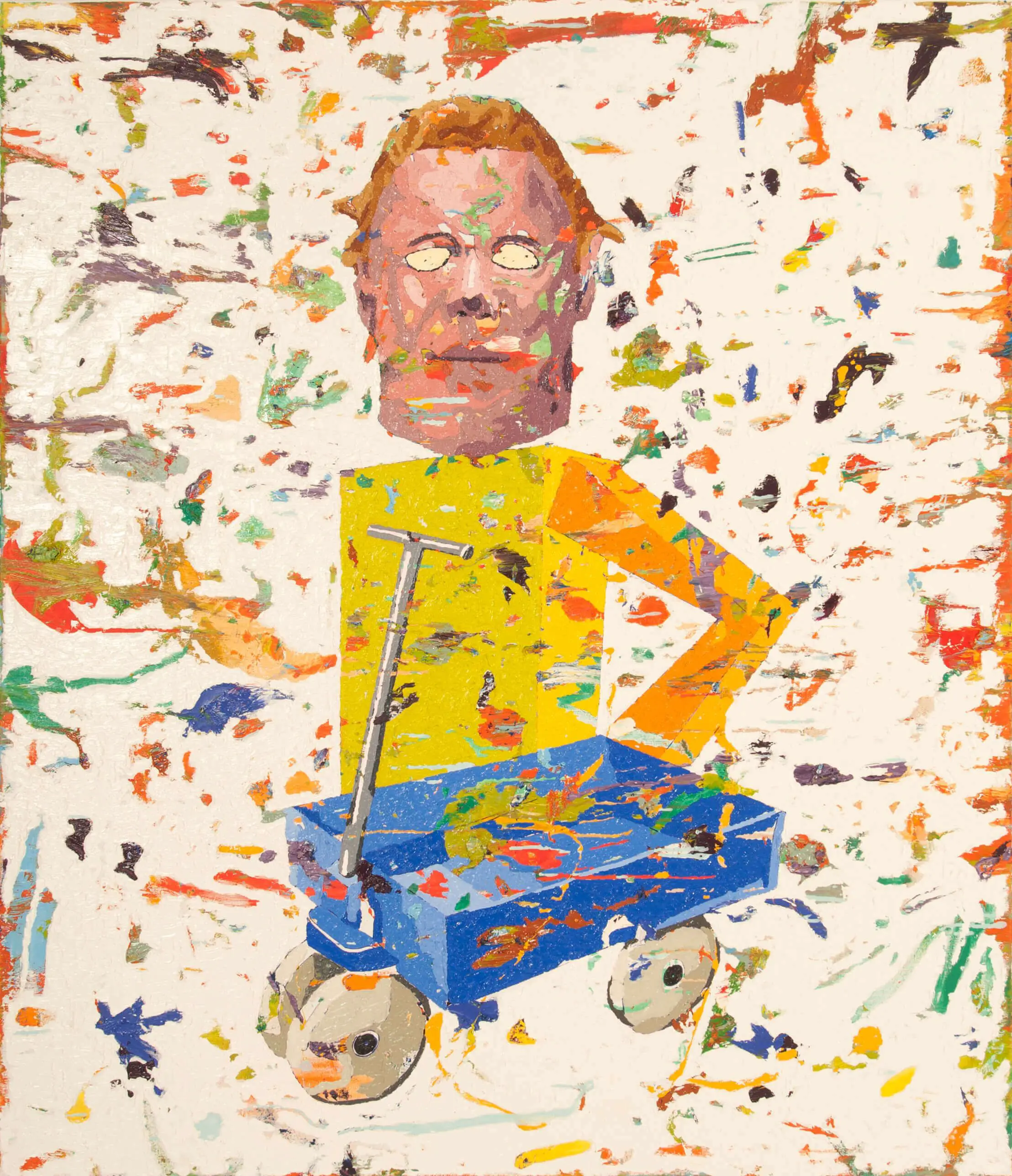
Arjan Pregl, Dan čarovnic, iz serije Karneval (2018). Photo: Galerija Y
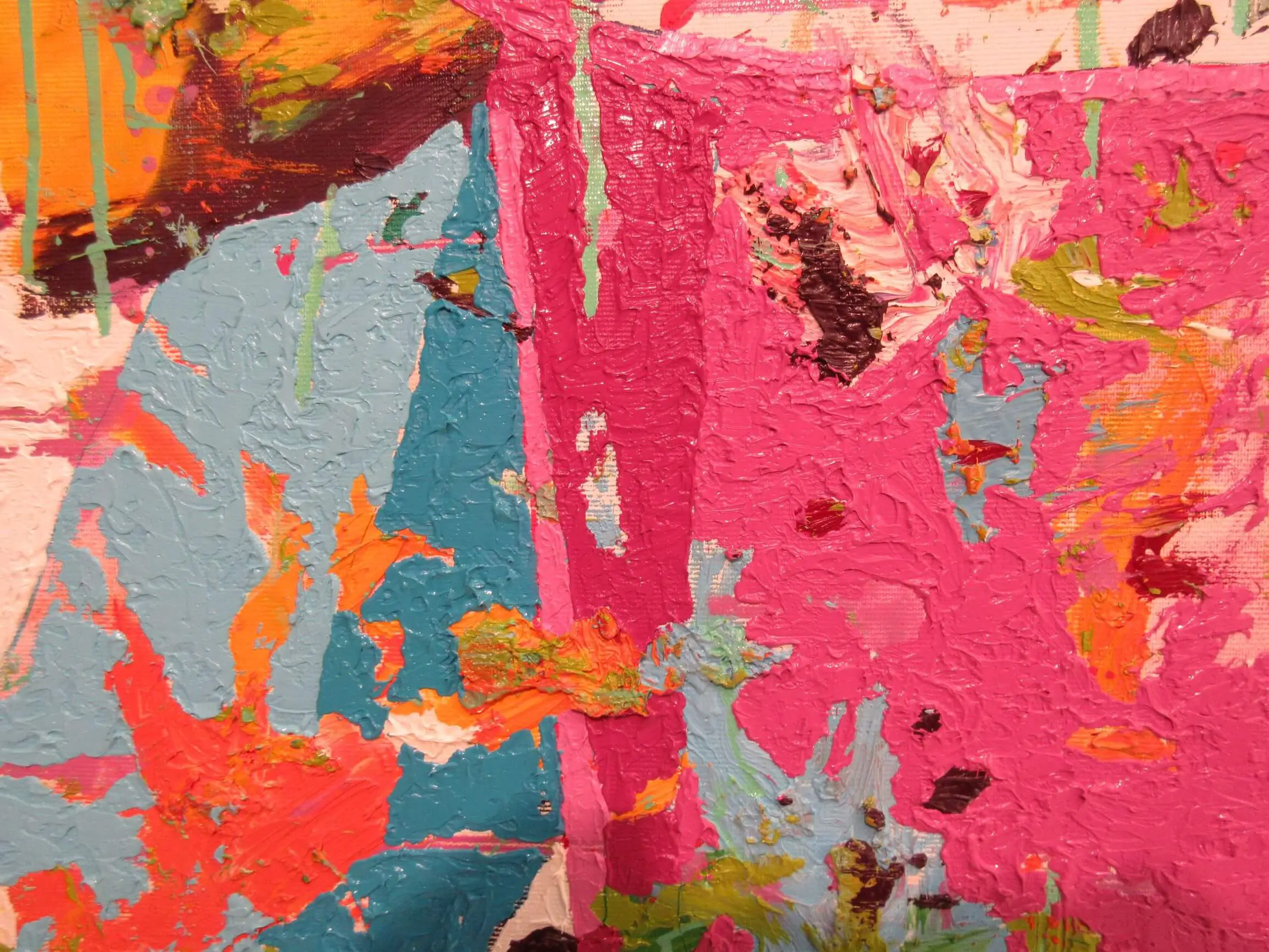
Arjan Pregl, Shrek z žago, iz serije Karneval (2018) - detail. Photo: JL Flanner
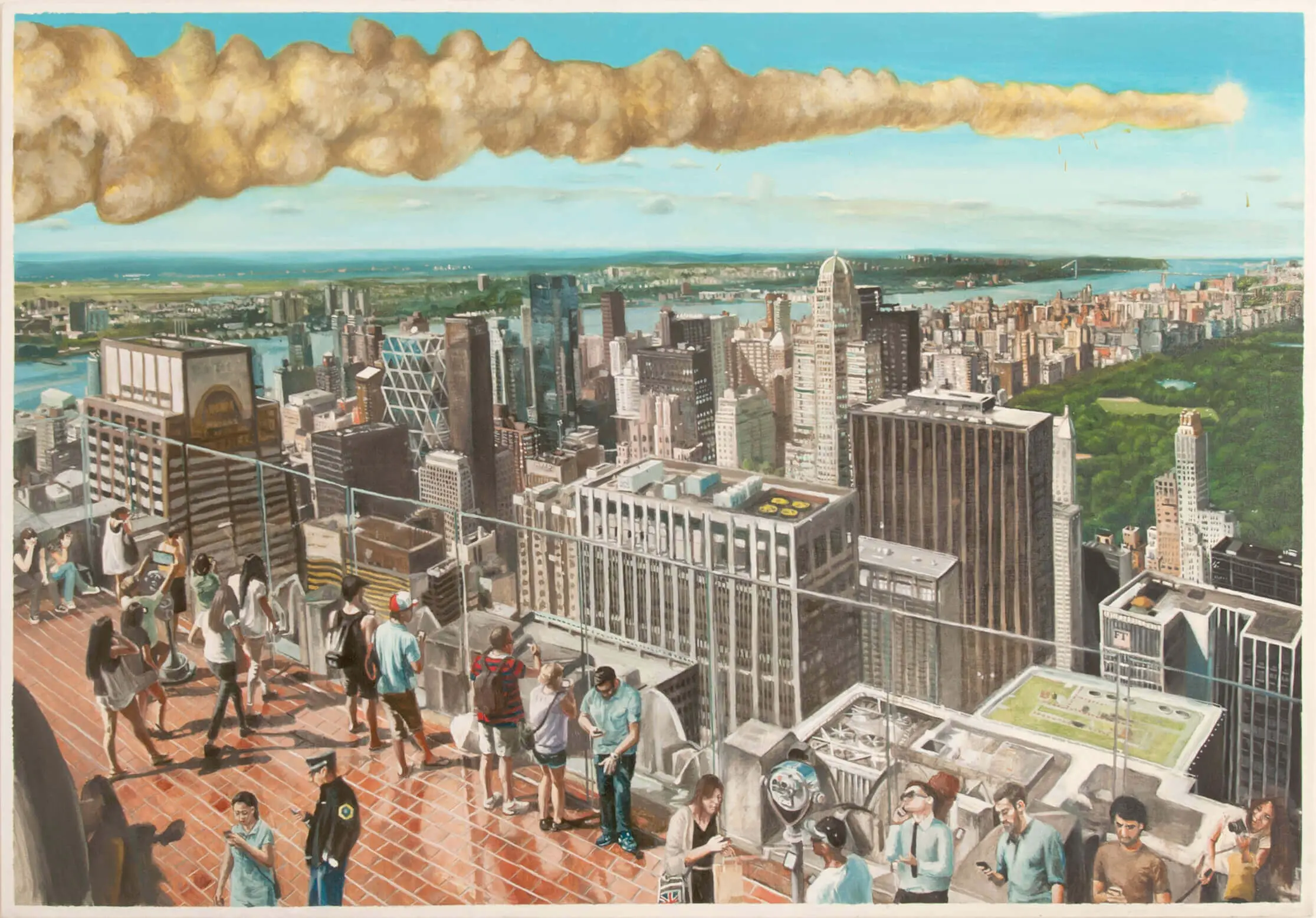
Sašo Vrabič, Vrh krize 2 (2019). Photo: Galerija Y

Sašo Vrabič, Romeo, (2019) - detail. Photo: JL Flanner
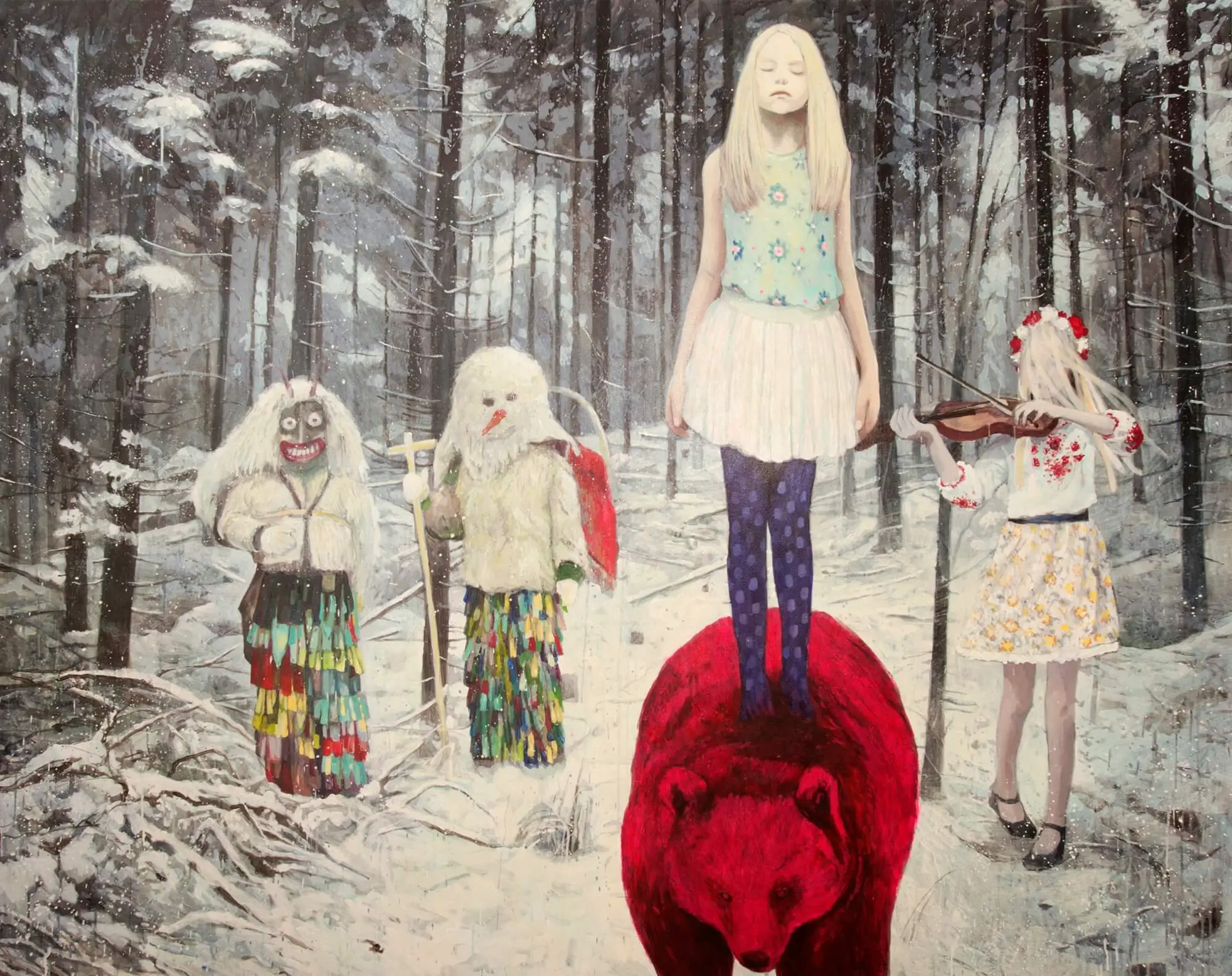
Tina Dobrajc, Enemy of the State II: Desperate Kingdom of Love (2019). Photo: Galerija Y
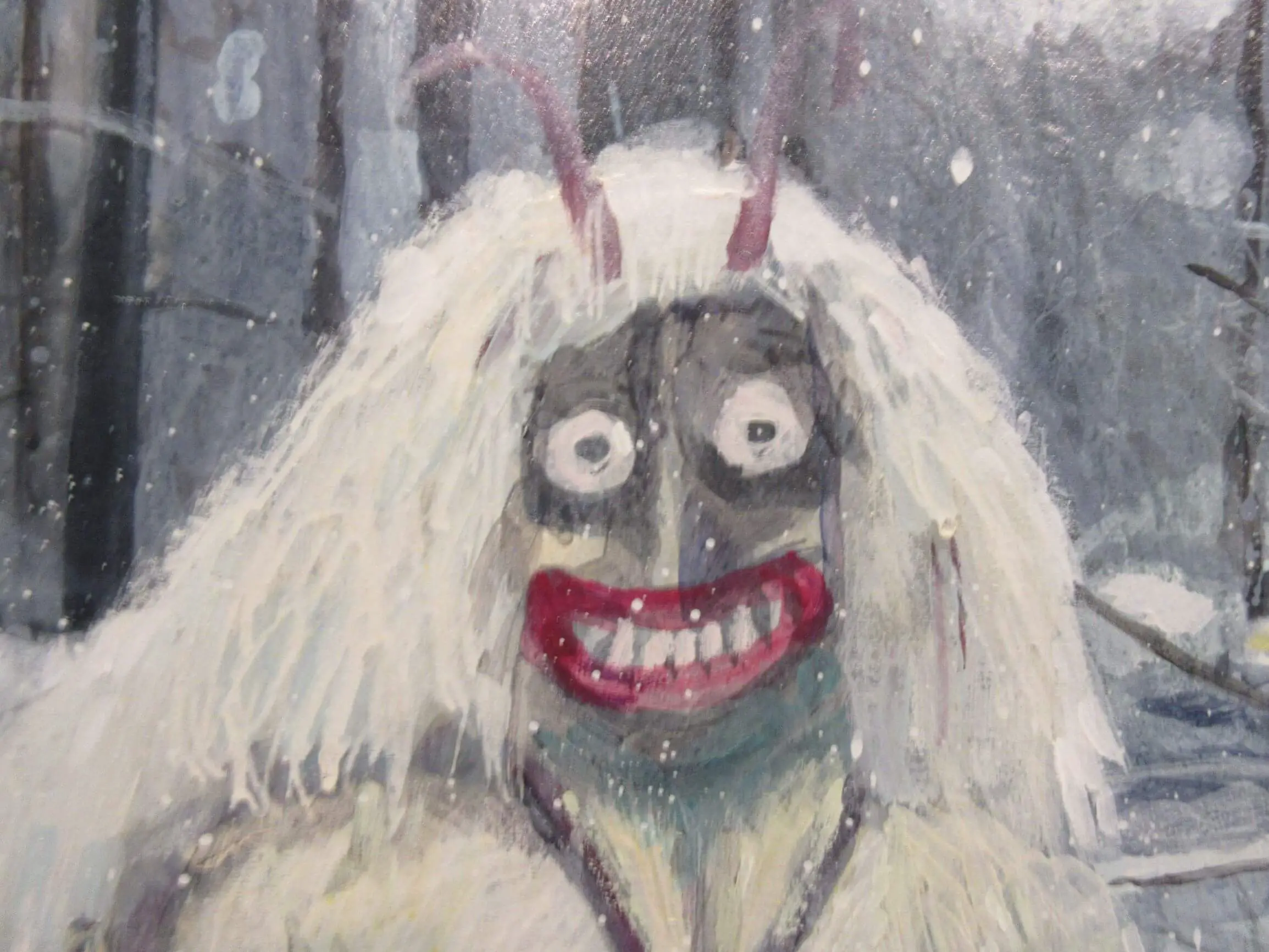
Tina Dobrajc, Enemy of the State II: Desperate Kingdom of Love (2019) (detail). Photo: JL Flanner
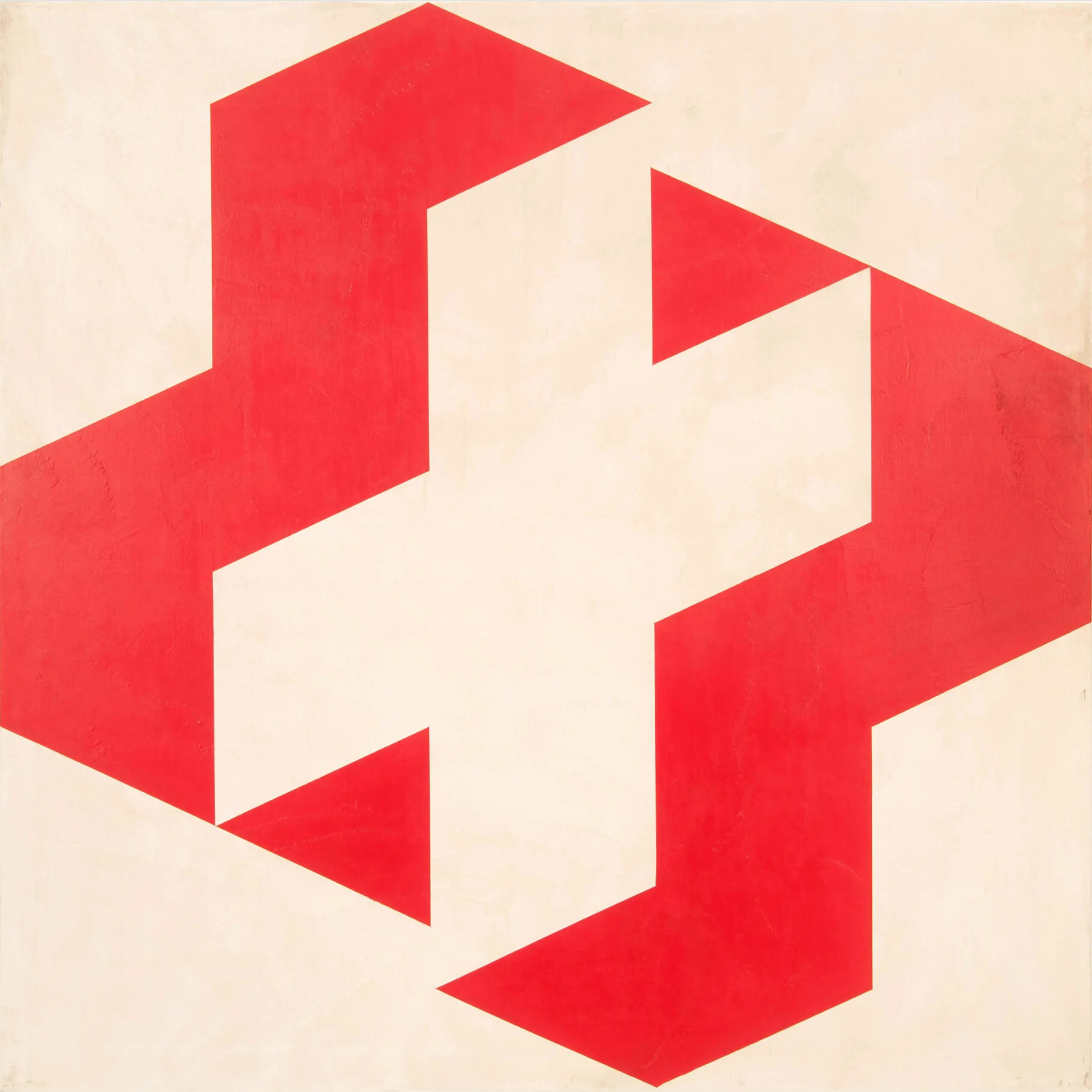
Duša Jesih, Red Cross (2019). Photo: Galerija Y
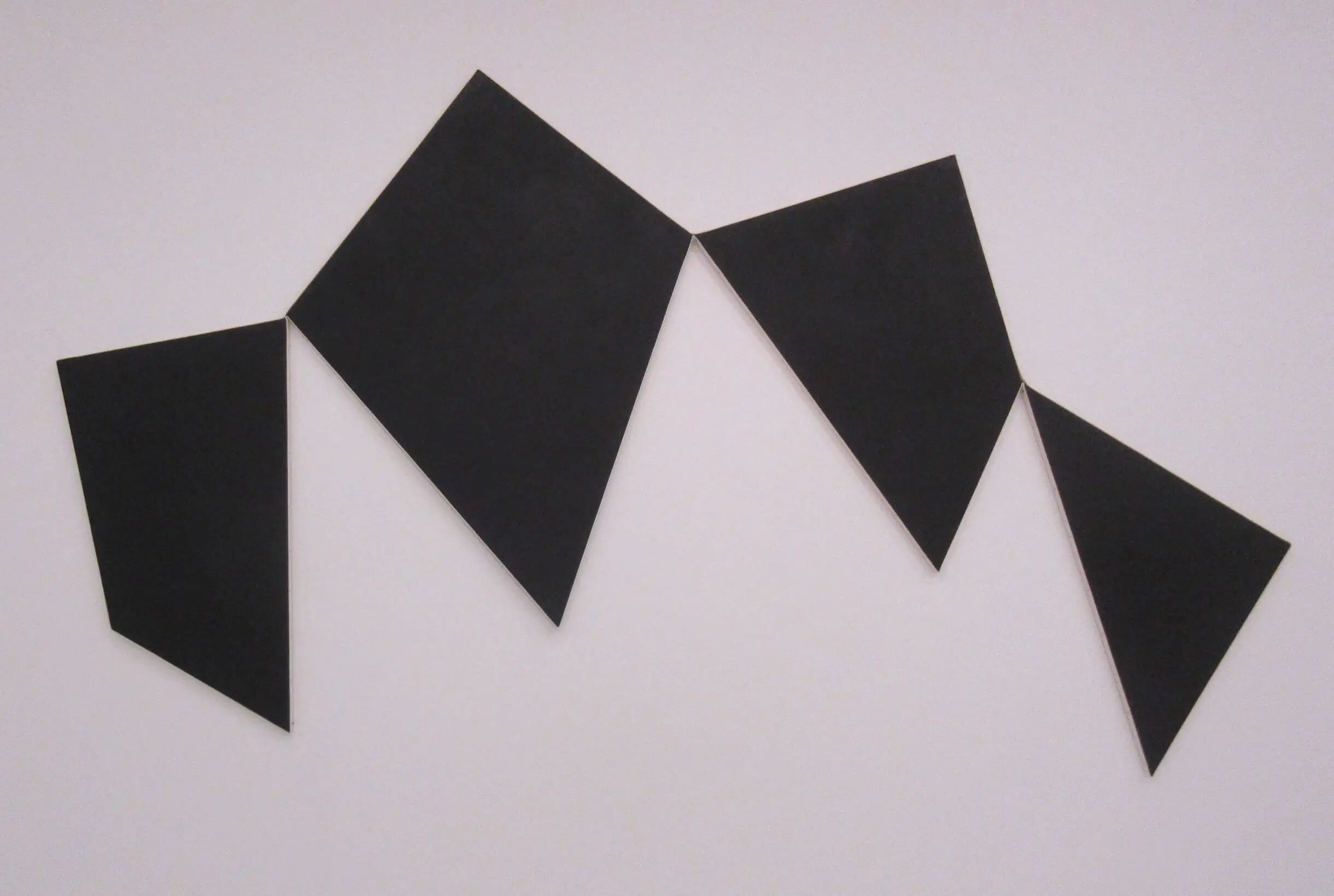
Duša Jesih, Never Really Here I, (Re)konstrucija), Hommage a Malevich (2017). Photo: JL Flanner
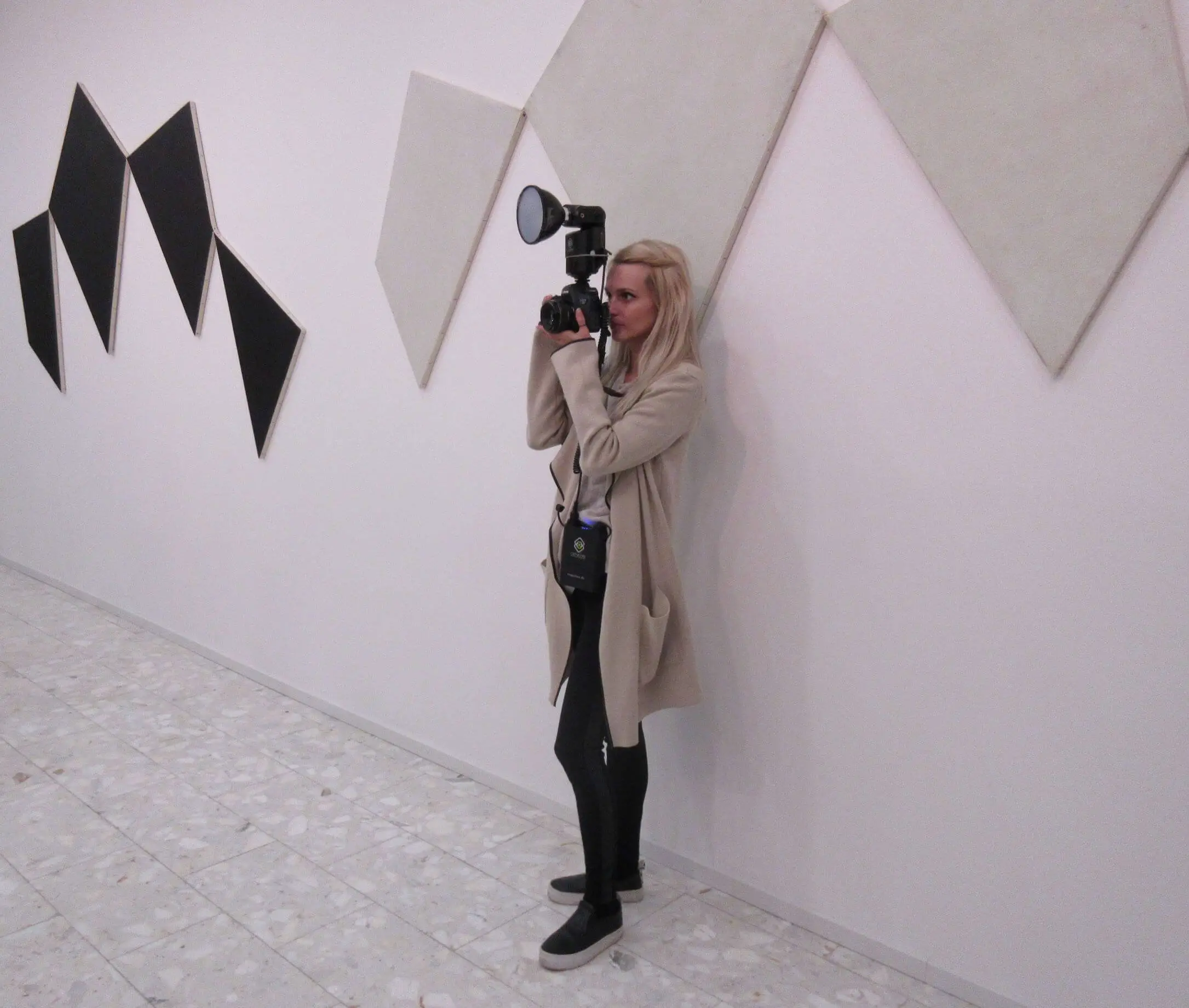
Photo: JL Flanner
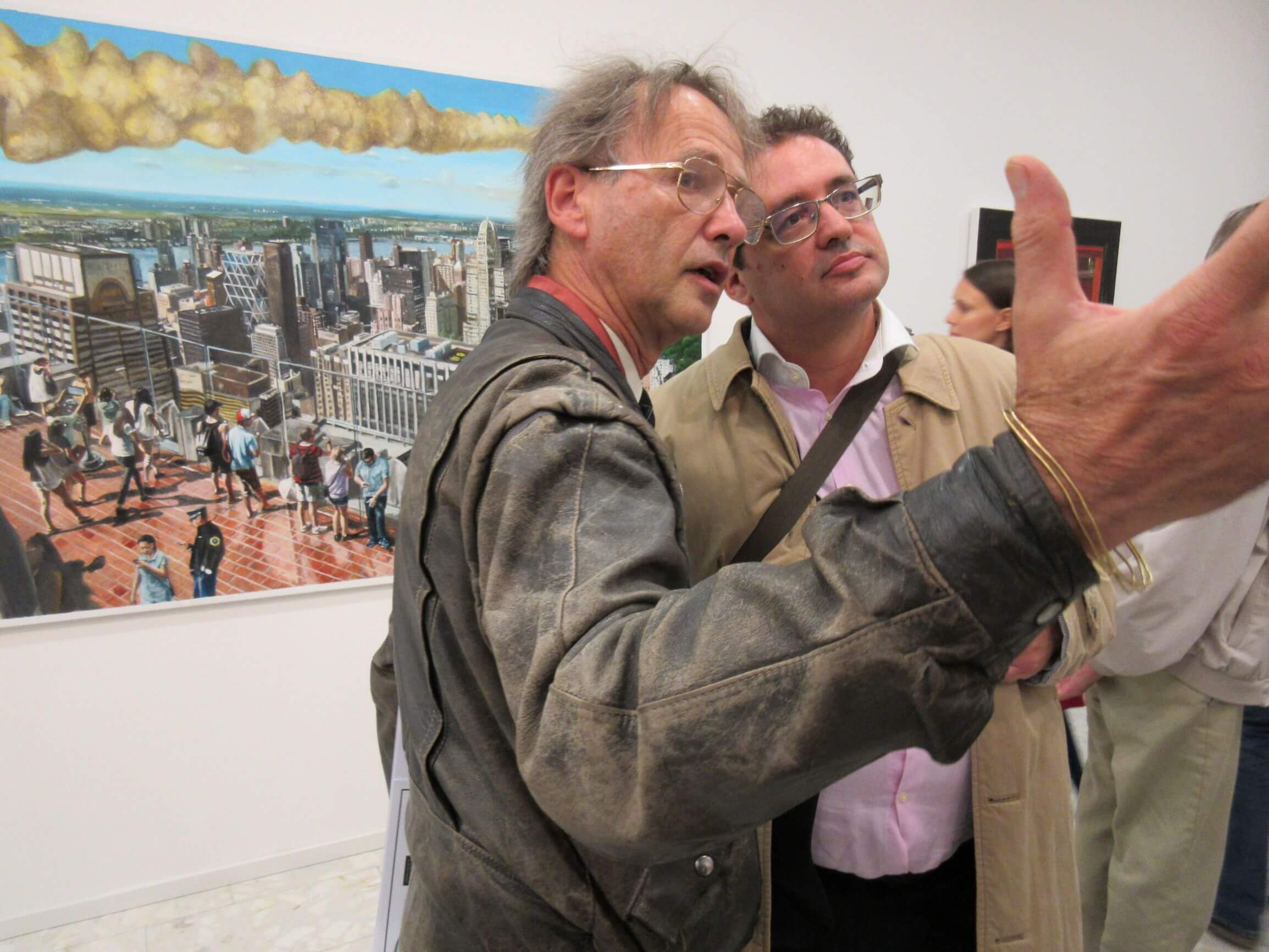
Photo: JL Flanner
You can learn more about Galerija Y here, and pay a visit at 79 Trubarjeva cesta, 1000 Ljubljana.


